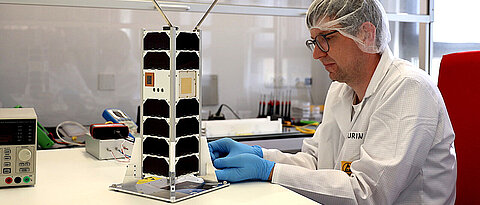
SONATE, the latest satellite engineered at the University of Würzburg, was lofted into space on Friday. Its mission is to test cutting-edge technology developed at the University of Würzburg in orbit.
more
SONATE is a nanosatellite engineered as a 3U-Cubesat. The aim of the project is to develop and operate a technology testing satellite for highly autonomous payloads. After launch SONATE is operated by SONATE Mission Control Centre of the professorship for space technology assisted with two ground stations owned by chair 8 at Campus Nord of Würzburg University.
The beginning of the project: 01/02/2016
Duration: 4 years
Funding Code: 50RM1606
Contact:
SONATE is a nanosatellite engineered as a 3U-Cubesat. After launch SONATE is operated by SONATE Mission Control Centre of the professorship for space technology assisted with two ground stations owned by chair 8 at Campus Nord of Würzburg University.
Primary Goals:
Verification of the main/key elements of the following two autonomous payloads in earth orbit:
Secondary Goals:
The project is managed by the Space Agency of the German Aerospace Center (DLR) under grant number 50RM1606 and funded by the Federal Ministry of Economics and Technology (BMWi).

SONATE, the latest satellite engineered at the University of Würzburg, was lofted into space on Friday. Its mission is to test cutting-edge technology developed at the University of Würzburg in orbit.
more
The University of Würzburg has two new space projects in the pipeline which are concerned with the observation of planets and autonomous fault correction aboard satellites. The German Federal Ministry of Economic Affairs and Energy funds the projects with around 1.6 million euros.
moreStatus 03.06.2020
Software updates have been uploaded and installed to improve the telecommand capabilities of the satellite.
Status 29.04.2020
Tests of the Attitude Control and Determination System (ADCS) were carried out and previously recorded attitude data was evaluated.

SONATE 3D model of the satellite orientation during the pass over Würzburg on February 28th, 2020. Displayed using the live telemetry data transmitted by the satellite.
Status 14.04.2020
 |
A number of attitude determination tests using the AROS star sensors have been sucessfully carried out. The animation (10x speed) shows a typical course of stars recognized by the sensor.
Status 09.03.2020
Part of the first image of earth taken by a satellite of the university of Würzburg.
The image was captured on 28.02.2020. This highly compressed section of the complete image was transmitted via the own analogue SSTV Transmitter using amateur radio frequencies. This picture also contains the satellite call sign. The transmission of the original image in full resolution will take place at a later time.
Status 11.02.2020
Through a sequence of experiments both AROS star sensors were sucessfully tested. All three reaction wheels were also further examined. All three reaction wheels are fully functional and will be subject to more experiments during the next few days.
One of the pictures taken by the AROS star sensor (slighly enhanced)
Status 23.01.2020
After a successful update of parts of the satellite, telemetry data of several days was recently downloaded. Further tests of the ADCS system are planned shortly.
Trend of the temperatures of the on-board processor and the power board as well as the charge currents of a solar panel over 11 orbits on January 11, 2020.
Status 11.12.2019
Since the last update several additional satellite components (among others ASPA, SSTV1, SSTV2 as well as AROS1 and AROS2) were put into operation and tested.
Status 16.09.2019
Since launch we have received more than 5000 telemetry frames from SONATE. At the moment the satellite is being commanded regularly in order to test the satellite's components. Recently one reaction wheel was successfully tested and measurements including rotation-speeds as well as further diagnostics telemetry of the attitude control system were received.


SONATE was successfully launched on July 05 2019 from Vostochny Cosmodrome as secondary payload of a Soyuz-rocket. The satellite broadcasts telemetry data on amateur radio frequencies according to this format: SONATE telemetry format

The team behind SONATE with Prof. Dr. Hakan Kayal (fourth from the left), University president Prof. Dr. Alfred Forchel (center) and projekt leader Oleksii Balagurin (fifth from the right). (Picture: Kristian Lozina / Universität Würzburg)

SONATE Mission control (Picture: Kayal)
SONATE UHF/VHF and S-Band ground stations (Picture: Kayal)
SONATE Satellite and On-Board controller (Picture: Kayal)

SONATE Integration laboratory and cleanroom (Foto: Kayal)

SONATE Testing facilities: Shaker (left) and thermal-vaccum chamber (right) (Picture: Kayal)

SONATE Air-bearing table and Magnetic field simulator(Picture: Kayal)


